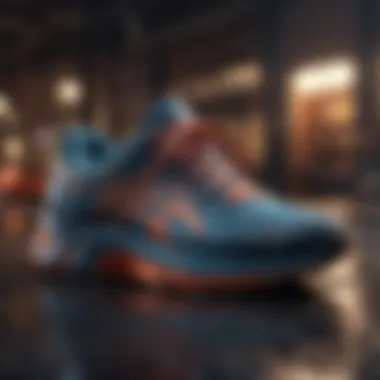Top Running Shoe Brands: Features and Innovations


Overview
Preamble to the topic of the article
In the realm of athletic pursuits, selecting the right pair of running shoes is paramount. This goes beyond mere aesthetics. It revolves around comfort, performance, and the ability to prevent injuries. As runners venture onto different terrains and seek varied experiences, the importance of understanding optimal brands cannot be overstated. The market is teeming with choices, each with its own lore and engineering designs.
Brief background information
The evolution of running shoes has come a long way over the decades. Originally crafted from simple canvas materials, today’s options integrate sophisticated technologies and materials for improved performance. Brands like Nike, Adidas, and Asics have risen to prominence, setting the stage for keen competitors and new entrants. With every brand striving to carve out its niche, discerning athletes face the challenge of navigating through an often-overwhelming array of options.
Features & Specifications
When sifting through the sea of running shoes, it’s essential to pinpoint what features set each brand apart:
- Cushioning System: Not all runners have the same needs; while some prefer a plush feel, others lean towards a firmer ride. Brands like Hoka One One are recognized for their maximalist cushioning.
- Stability Components: For overpronators, shoes with arch support offer necessary stability. Brands such as New Balance have established themselves as reliable choices for such specific requirements.
- Outsole Design: Traction plays a crucial role. The outsole rubber used in brands such as Saucony and Merrell is engineered for durability and grip across various surfaces.
- Breathability: A mesh upper enhances ventilation. Companies like Salomon have made strides in this arena, ensuring that feet remain cool during vigorous activities.
Pros and Cons
Advantages
- Established reputations, with brands like Brooks and Mizuno often regarded for their dedicated running focus.
- Innovative technologies, such as Nike's Flyknit or Adidas' Boost, that promise enhanced performance.
- Wide variety available catering to different foot shapes and running styles.
Disadvantages
- Price points can be a barrier for many. Premium brands often come with a higher cost, making it difficult for budget-conscious buyers.
- Availability can sometimes be an issue; certain models might sell out quickly or be hard to find outside specialty stores.
User Experience
Real-world preferences shape the landscape of running shoes uniquely. Reviews from running communities offer invaluable insights:
“I switched to Asics after years of trying different brands, and I can’t believe I waited so long! The support is fantastic for longer runs.” – Rachael, avid marathon participant.
Some users praise Altra’s wide toe box for comfort, while others tout the responsiveness of the Saucony Endorphin series during sprints. Performance metrics are often expressed through personal testimony, proving the shoes’ worth amid the rigors of everyday training.
Buying Guide
For those on the hunt for the perfect running shoe, a methodical approach can save time and enhance satisfaction:
- Assess Your Running Style: Are you a casual jogger or a competitive athlete? Consider how often you run and on what terrain.
- Understanding the Fit: Make sure to try on various brands. Sizes and fits can differ remarkably.
- Research Brands: Look into the brand’s history and innovations. Studies show that loyal customers often favor brands with a strong narrative and established technology.
- Budget Consideration: With prices varying significantly, it’s wise to set a budget beforehand. Sometimes promotions or out-of-season sales can yield excellent bargains.
- Test Runs: If possible, take a test run on a treadmill or an open track to feel the shoes in action.
Ultimately, choosing running shoes involves balancing personal preferences with brand merits. As technology advances and more athletes engage with different brands, the journey to find optimal footwear becomes an ever-exciting endeavor.
Prelims to Running Shoe Brands
When it comes to running, the shoes on your feet can make or break the experience. Choosing the right pair is like picking the right tool for a job; it can mean the difference between smooth sailing and a bumpy road. The world of running shoe brands is vast, stretching from industry titans to niche players, each presenting a unique take on what the ideal running shoe should be.
This section dives into the cruciality of understanding different running shoe brands and their offerings. It's not merely about color or brand identity; it's about the performance metrics, the technologies used, and how these elements cater to diverse runner needs.
Moreover, the significance of knowing about various brands extends into practical realms. For instance, runners who've had past injuries can benefit tremendously from selecting a shoe with adequate support. Others, whose feet might have special requirements, are better served by brands that focus on a specific niche. In short, educating oneself about running shoe brands arms the athlete with key insights that can enhance their performance and enjoyment.
The Importance of Choosing the Right Running Shoes
Running shoes aren’t just a fashion statement; they’re an investment in health, performance, and overall running experience. Wearing the wrong shoes can lead to discomfort, blisters, and even long-term injuries like shin splints or plantar fasciitis. For someone who pounds the pavement, picking shoes that fit well and suit their running style is as vital as the miles they plan to clock in.
Consider this: a well-fitted, quality running shoe can improve your running economy, helping you use less energy and run faster. On the flip side, a poorly chosen shoe can dampen your motivation and keep you off the trails. When you think about it, each step you take should feel both natural and supported. Prioritizing the right footwear translates into a more enjoyable running experience, one that boosts confidence and encourages consistency.
Key Factors Influencing Shoe Selection
Selecting the optimal running shoe isn’t a one-size-fits-all process; rather, it’s like a balanced recipe that mixes multiple ingredients. Here are the paramount factors that should guide your choice:
- Foot Type: The shape of your foot can dictate your ideal sneaker design. Flat feet may need stability shoes, while those with high arches often benefit from cushioned options.
- Gait Analysis: Professionals can assess whether you’re a neutral, overpronator, or supinator. This analysis informs you about the level of support your shoes should offer.
- Terrain: The surfaces you typically run on matter. Trail running shoes come with different traction and protective features than road running shoes.
- Cushioning Preference: Some runners prefer a plush feel that absorbs shock, while others might favor a firmer base for better feedback.
"The right running shoes are less about the brand and more about matching your needs with what’s available."
Exploring these brands and their unique selling propositions allows for a more personalized approach to choosing the right running partner—your shoes.
Overview of Popular Running Shoe Brands
The landscape of running shoes is garnished with brands that not only speak to performance but also resonate with runners on a personal level. The choice of a running shoe can make or break an athlete's experience, enhancing the joy of running while preventing injuries. Understanding the nuances of popular brands helps runners find that perfect match which aligns with their specific needs, preferences, and goals.
In this segment, we will delve into a selection of well-regarded running shoe brands including Nike, Adidas, Asics, Saucony, and Brooks. Each brand offers distinctive features and technologies that cater to different athletic demands. By examining these brands, we equip ourselves with knowledge that can significantly influence our purchasing decisions, ensuring we prioritize comfort, durability, and style on our running journeys.
Nike: Innovation and Performance


History of Nike in Running
Nike kicked off in the late 1960s with its early ties to the running community, quickly establishing a reputation for cutting-edge designs aimed at enhancing runner's performance. The brand's history in the running sector is marked by a commitment to innovation, seen in their gradual evolution from basic shoes to advanced technology. Nike often brought ideas that were unheard of, like the introduction of air cushioning which revolutionized how shoes felt during long runs.
People often find Nike appealing due to its well-recognized branding and endorsement by top athletes. However, the high price point can be a drawback for budget-conscious consumers.
Technological Advancements
Nike has consistently pushed the envelope with its technological advancements. The Nike React foam, for example, offers both cushioning and responsiveness, making it ideal for long-distance runs. The Flyknit technology enhances the upper part of the shoe, providing a snug fit while reducing weight. These technologies improve not just performance but also the overall running experience.
That said, some users have cited that the durability of certain models can be lacking when put to the test over time. Yet, athletes who crave that sprint-like feel often opt for Nike without a second thought.
Popular Models
Among Nike's extensive range of models, the Nike Air Zoom Pegasus stands out as a favorite. It's lauded for its blend of comfort and responsiveness, making it a go-to for both amateurs and seasoned runners alike. The stability offered encourages those transitioning into more intensive runs. Also worth tracking is the Nike ZoomX Vaporfly, designed for speed enthusiasts aiming to break records.
While they tend to be on the pricier side, runners argue the technology and performance payoff justify the cost.
Adidas: Revolutionizing Running Footwear
Brand Philosophy
Adidas prides itself on blending tradition with modern innovation. The brand's mantra of “Through Sport, We Have the Power to Change Lives” emphasizes how impactful the right gear can be. Its philosophy revolves around creating sustainable and ethically produced products, which resonates well with a growing segment of environmentally-conscious consumers. This commitment to sustainability infuses their models with value beyond just performance.
However, with the focus on sustainability, there’s a talk about the trade-off in price, as many models might be slightly above average in cost.
Key Technologies
Adidas pushes the limits with its Boost technology, known for delivering exceptional energy return. This unique cushioning system adds both comfort and responsiveness, making it attractive for runners needing that extra push during their workouts. The brand also invests heavily in developing lightweight materials, which can sometimes compromise durability.
But many rave that the lightness translates into quicker times on the track, making it a desirable attribute.
Top Choices for Runners
Runners seeking a responsive shoe often turn to the Adidas Ultraboost, a model that not only provides comfort but also offers style. Another staple, the Adizero series, is specifically designed for speed and efficiency. It caters to those looking for performance-enhancing attributes in their gear. While the Ultraboost is known for daily training, the Adizero makes waves in races; both have their place in the running community.
However, some users find these shoes may not provide enough support for longer distances.
Asics: A Focus on Comfort and Support
Unique Selling Proposition
Asics stands out with its 'Sound Mind, Sound Body' philosophy, highlighting the relationship between mental well-being and physical health. The brand is well-regarded for its focus on comfort, especially in terms of cushioning and arch support. Its unique selling proposition centers around ensuring that runners feel good while hitting the pavement, making it a favorite among those prone to discomfort or injuries.
Despite its labeling as more comfort-driven, runners frequently find their performance remains uncompromised.
Signature Technologies
The gel technology found in Asics shoes is renowned for its shock absorption, allowing for a smooth ride. Many athletes, especially those with joint concerns, favor this characteristic, ensuring that each step feels cushioned. This technology caters to a variety of running styles and needs. However, some users note that it may lead to excessive compression over long durations, leading to uneven wear.
Bestselling Shoes
The Asics Gel-Kayano is arguably the most popular shoe within their lineup, combining cushioning and stability, particularly beneficial for overpronators. On the other hand, the Gel-Nimbus is known for its plush comfort, making it perfect for long distances. While these shoes are often favored for their comfort, their premium price point may deter some potential buyers.
Saucony: Tailored for Performance
Performance Metrics
Saucony has made a name for itself by focusing on performance metrics that matter to serious athletes, such as weight, cushioning, and flexibility. Their shoes are designed to enhance performance without sacrificing comfort. Runners often find they can push harder for longer, which is valuable for those training for races or simply aiming for personal bests.
Though comfortable, some users lament that they lack the aesthetic appeal of rival brands.
Brand Evolution
Saucony has transformed over the decades, evolving its shoe designs based on scientific research and athlete feedback. This adaptability ensures they stay relevant, constantly fine-tuning their shoes to meet the specific demands of runners today. As they innovate, Saucony doesn’t lose sight of their core offerings, ensuring they still resonate with loyal customers.
Still, their focused approach may not appeal to casual runners seeking fashion-first styles.
Suitable Models for Various Runners
The Saucony Triumph series is a go-to for those looking for maximal cushioning without losing feeling on the road. Alternatively, the Saucony Kinvara is perfect for speedsters focusing on lighter options, appealing to those who prioritize racing over training. While these models are celebrated for their performance metrics, potential buyers should consider that too much cushioning might not favor everyone.
Brooks: Dedicated to the Runner's Experience
Community Involvement


Brooks Running has a distinct ethos of community involvement and encouragement, striving to foster an inclusive environment. The brand's dedication to runner advocacy resonates with many, as it promotes not just the equipment but also the joy of running itself. They invest in local events and initiatives to help build running communities.
However, Brooks may not have the same widespread recognition in mainstream culture, affecting its visibility.
Technological Innovations
Brooks invests heavily in refining its technology, such as their BioMoGo DNA cushioning which adapts to the individual runner's stride. This adaptability enhances performance by offering tailored support with every step. Many users find that it helps distribute pressure evenly throughout the foot, leading to better energy conservation.
On the flip side, some runners may find it takes time to adjust to the unique feel of Brooks shoes.
Highly Rated Shoes
The Brooks Ghost is often recommended for its balance of cushioning, support, and responsiveness, making it suitable for runners of all levels. Another favorite, the Brooks Adrenaline GTS, offers stability, which many overpronators appreciate. The high ratings of these shoes validate Brooks' commitment to providing products that prioritize the runner’s experience, though prices may vary across different models.
Analyzing Specialty Brands
When it comes to choosing running shoes, understanding the nuances of specialty brands like Hoka One One, Altra, and New Balance becomes essential. These brands are not just ordinary names in the market; they bring unique characteristics and design philosophies that cater to specific runner needs. Analyzing specialty brands allows us to focus on their standout features, technological innovations, and how they cater to different demographics of runners. It's not just about finding a shoe; it’s about finding the right shoe that matches your running style, terrain, and personal preferences.
Hoka One One: The Cushioning Champion
Design Philosophy
Hoka One One has carved out a niche for itself through its unique design philosophy, which emphasizes maximum cushioning without compromising weight. The key characteristic here is the brand's signature "maximalist" style, allowing for a plush feel that fosters comfort. This design is beneficial for long-distance runners and casual joggers alike, as it absorbs impact effectively. One notable feature is the "Meta-Rocker" technology; it’s designed with a unique sole shape that promotes a smooth transition from heel strike to toe-off. This makes it easier on the joints, though some may find the cushioning a bit excessive for shorter runs.
Target Audience
Hoka’s target audience mainly includes long-distance runners and those recovering from injuries. Their shoes are popular among individuals who need extra support or cushioning due to prior foot problems or those who just prefer a plush ride. The most significant aspect of this target audience is that they encompass people of various fitness levels. However, a unique drawback lies in the aesthetic; some prefer minimalist designs, which Hoka does not prioritize.
Recommended Models
When diving into the recommended models, Hoka One One's Clifton and Bondi series stand out as top choices. These models cater to a wide array of runners, thanks to their reliable cushioning and support. A key characteristic of these shoes is their lightweight nature, which is somewhat counterintuitive given their level of cushioning; this gives runners the best of both worlds. However, the deep cushioning might not cater well to everyone, especially those who enjoy a more connected, ground-feel experience.
Altra: The Zero Drop Movement
Unique Design Features
Altra has earned a following primarily due to its unique zero-drop platform. This means that there is no elevation difference between the heel and forefoot. This design plays a pivotal role in promoting proper form and alignment during runs. The key characteristic here opens up a world of benefits, especially for those prone to injuries from traditional shoes’ elevated heels. A unique feature is the "FootShape" toe box, which allows the toes to splay naturally, enhancing stability but may feel awkward for those used to a tighter fit.
Best Applications
Altra shoes excel on trails and urban settings alike. They are particularly beneficial for trail runners and individuals seeking shoes that support natural foot movement. This adaptability marks them as a best application fit for varied terrains. However, runners transitioning from traditional shoes might need time to adjust to the zero-drop feature, which could feel quite different at first.
Customer Reviews
Customer feedback on Altra shows strong brand loyalty, especially among those who prioritize comfort and natural movement. Many reviewers highlight the immediate comfort and reduced foot pain after switching to Altra. However, on the flip side, some users have noted that the fit can vary significantly across models, which may require them to try several pairs before finding the perfect one.
New Balance: A Blend of Tradition and Performance
Heritage and Culture
New Balance holds a significant place in running culture due to its rich heritage spanning over a century. This history is integral to its brand identity, associating it with quality and performance. New Balance has retained a loyal following, primarily because of its commitment to producing shoes in the United States and maintaining high manufacturing standards. This commitment to heritage benefits those looking for tradition-based performance, though some might argue it sometimes falls behind in cutting-edge technology compared to newer brands.
Endorsements and Collabs
The endorsements and collaborations New Balance pursues are noteworthy and play a sizable role in its popularity. Working with athletes and influencers elevates its branding and provides a level of trust among consumers. Unique collaborations, such as limited edition sneakers and partnerships with fashion icons, not only broaden their reach but also attract customers who may not be focused solely on performance. Still, some limited releases can create a sense of accessibility issues for regular customers who can't get them.
Key Models Overview
Key models like the Fresh Foam and 990 series exhibit New Balance's blend of performance and tradition. These models offer cushioned support and excellent flexibility, making them popular choices for everyday runners. The characteristic here is quality craftsmanship, often regarded as premium in the market. However, their price point reflects this, and budget-conscious consumers might find them a tad on the expensive side.
"Understanding specialty brands equips runners with the knowledge to choose shoes that genuinely align with their physical needs and running styles."
By examining these specialty brands, it becomes clearer that each offers innovative solutions to meet specific requirements within the running community. Whether it’s the cushioning of Hoka, the zero-drop philosophy of Altra, or the heritage of New Balance, runners must consider their own unique needs as they select the optimal footwear for their pursuits.
Evaluating Brand Performance Metrics
When it comes to selecting running shoes, evaluating brand performance metrics is essential for ensuring that you’re making an informed choice. This part of the article delves into quantifiable factors that can significantly affect your running experience. These metrics not only provide insight into a shoe's quality but also help runners, whether beginners or seasoned athletes, to align their choices with personal preferences and needs. Knowing how shoes perform in terms of durability, weight, and fit allows consumers to make better decisions, ultimately leading to a more satisfying running experience.
Durability and Longevity
Durability is a crucial element every runner should consider when purchasing new footwear. A shoe that manages to withstand the wear and tear of regular running will typically save you money in the long run.
Generally, the materials used in manufacturing play a big role here. For example, synthetic materials often boast higher durability than natural fabrics. However, it’s not just about the outer layers. The midsole, which cushions your foot, also needs to maintain its integrity over time. A worn midsole defeats the purpose of cushioning and can lead to injuries.
- Common Durable Materials:


- Mesh: Breathable yet prone to wear.
- Rubber Outsoles: Resistant to abrasion and can provide good traction.
"Investing in shoes known for their durability can significantly lessen the frequency of replacements."
For instance, brands like Asics and Brooks have built a reputation for their long-lasting performance. Users often find that their shoes last well over 500 miles when cared for properly. This longevity can contribute to a more sustainable running lifestyle, not just for your wallet, but for the environment as well.
Weight vs. Performance
The balance between weight and performance is another metric that demands attention. Shoes that are too heavy can hinder speed and agility, while overly lightweight options may compromise support and cushioning. It's all about finding that sweet spot that aligns with your running style.
Lightweight running shoes are often heralded by competitive runners who thrive on speed. However, these shoes may lack sufficient cushioning, risking discomfort or injury during longer runs. On the other hand, heavier models typically feature enhanced support, which can be critical for those logging more substantial mileage.
- Considerations in Weight vs. Performance:
- Type of Running: Trail running necessitates more durable, heavier shoes.
- Individual Preferences: Some people prioritize speed, while others seek comfort.
Brands like Hoka One One focus on this dynamic by creating shoes that are lightweight yet offer robust cushioning, appealing to a broader audience, especially those who enjoy long-distance running or trail work.
Fit and Comfort Evaluation
Fit and comfort are arguably the most subjective but also the most pivotal aspects when evaluating running shoes. A perfect fit can transform your run from a chore into a joy, while poor fitting shoes can lead to blisters, soreness, or worse.
The fit generally encompasses aspects like width, arch support, and heel height. Runners should assess their own feet; knowing whether you have a narrow or wide foot, for example, can influence your choices significantly. Many brands now offer wide or narrow variations, recognizing that a one-size-fits-all approach fails to address individual needs.
When assessing comfort, consider the following:
- Cushioning Levels: Too much or too little can affect your stride.
- Arch Support: Proper support can help with alignment and reduce injury risk.
- Break-In Period: Some shoes require a breaking-in phase, while others are comfortable straight away.
a dedicated fan of Brooks might come away from a fitting feeling steady and secure, marveling at how a nicely cushioned midsole melds with the shape of their foot. Others might prefer Altra’s zero drop philosophy, which encourages a more natural running gait.
Market Trends in Running Shoe Brands
Understanding market trends in running shoe brands is crucial for anyone looking to stay ahead in their running game or simply choose footwear that meets their lifestyle needs. As the running community evolves, the demands on brands to keep pace become more pronounced. The significance of trends can’t be overstated; they not only reflect what consumers are seeking but also indicate how brands are responding to societal changes, technological advancements, and environmental concerns that have surfaced in recent years.
In this exploration, we will delve into three prominent trends affecting the market: sustainability in footwear, the rise of customization, and technological integration in shoes.
Sustainability in Footwear
Sustainability is no longer just a buzzword; it has become a priority for many brands and consumers alike. The push towards more eco-friendly practices in the production of running shoes signals a shift in consumer preferences. Brands are increasingly scrutinizing their supply chains and seeking alternative materials that minimize environmental impact. For example, some companies are turning to recycled plastics, organic cotton, and sustainably sourced materials to create their products. This trend not only helps reduce the carbon footprint but also resonates with ethically-minded consumers.
Here are some key elements surrounding sustainability in running footwear:
- Material Innovations: Brands are developing new materials that are recyclable or biodegradable. These innovations appeal to consumers who are conscious of their environmental footprint.
- Transparency: Many running shoe companies are making strides in transparency about their manufacturing processes. This clarity builds trust with consumers who want to know how their products are made.
- End-of-Life Programs: Initiatives that allow customers to return worn-out shoes for recycling are becoming more common, giving consumers an avenue to contribute to sustainability efforts.
"The future of running shoes is not just about performance; it's about performance that respects the planet."
The Rise of Customization
In a world where individual tastes reign supreme, customization allows consumers to tailor their running shoes to fit not just their feet but also their personal style. Brands that offer customization options are tapping into the growing desire for individual expression. The process of designing a shoe with preferred colors, materials, and even specifications for fit not only heightens customer engagement but caters to specific needs—think wide feet or chronic ankle issues.
Custom options have become a draw for brands. Here’s what’s changing:
- Personal Fit: Customization allows shoes to be made to measure, addressing varying foot shapes and running styles that off-the-shelf models might not accommodate.
- Aesthetic Appeal: Giving customers the chance to showcase their personality through color and design can foster a deeper connection to the brand.
- Price Motive: Although customized shoes may come at a premium, many consumers see this as an investment in their comfort and overall running performance.
Technological Integration in Shoes
With the constant innovation in tech, running shoes have become more than just a piece of footwear—they are now gadgets in their own right. Wearable technology is increasingly integrated into shoes, allowing runners to access data about their performance directly from their footwear. Step tracking, gait analysis, and even feedback on running form are just the tip of the iceberg.
The growing trend of tech integration shows:
- Enhanced Performance Metrics: Shoes embedded with sensors monitor not just distance, but also running style, helping users identify areas for improvement.
- Smart Features: Innovations like embedded chips that track routes and performance stats in real-time cater to the tech-savvy runner.
- Mobile Connectivity: Apps that sync with running shoes provide detailed analytics, encouraging users to improve their performance by setting milestones and tracking progress.
Closure: Selecting the Right Brand for You
In the ever-evolving world of running gear, the importance of making an informed choice about running shoes cannot be overstated. It’s not just about the brand; it’s your comfort, performance, and ultimately, how you feel while you’re pounding the pavement or trail. As highlighted throughout this article, choosing the right brand involves a dance between personal preference, brand loyalty, and the individual needs dictated by your running style.
Personal Fit and Preference
Finding the ideal running shoe brand boils down to fit and personal preference. Every runner has unique dimensions and biomechanics, which means a shoe that works wonders for one person might be completely unsuitable for another.
- Know Your Arch Type: Understanding if you have flat, neutral, or high arches is crucial. Shoes like Asics provide great support for different arch types.
- Foot Shape Matters: People have varied foot shapes; some may have wide feet while others have narrow. Try brands like Altra, known for their spacious toe box.
- Size and Comfort: Don’t just go by the size label. Ensure there's enough room in the toe area, and that the heel is secure yet comfortable. It’s always advisable to try shoes on late in the day when your feet are slightly swollen, mimicking conditions during a run.
Aligning these parameters with your preferred brand can make all the difference. You’ll likely find yourself running longer and faster when your shoes feel just right.
Brand Loyalty vs. Experimentation
Brand loyalty can feel comforting, like an old pair of sneakers you can rely on. But is sticking to one brand always wise? A bit of experimentation can open doors to unexpected benefits.
- Sticking to the Familiar: Sure, familiar brands like Nike have established their prowess in the market. If a specific model has delivered for you in the past, it’s understandable to remain loyal—like returning to a trusty diner for your favorite dish.
- Exploring New Options: However, venturing out can lead to discovering innovations that better suit your running needs. Brands such as Hoka One One and Saucony are continuously pushing boundaries. Trying on different shoes, even if they’re from lesser-known brands, might surprise you.
- Feedback from Community: Engaging with runner communities on platforms like Reddit can yield personal stories and recommendations. With such diverse experiences, you might find a shoe that aligns perfectly with your own preference.
A balanced approach, blending brand loyalty with a willingness to explore, is key. Stay attuned to your running performance, and don't hesitate to step outside your comfort zone.







